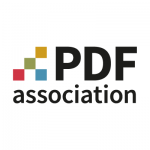
The new PDF 2.0 and subset standards
A brief survey of ISO 32000-2:2020 and its associated subset standards for archiving, print, transactional and variable print and raster imaging.
The just-released 2nd edition of PDF 2.0, ISO 32000-2:2020 replaces the 2017 edition. This is the finalized publication that we previously discussed; what ISO calls a ‘dated revision’.
In addition to many important clarifications and corrections to the 2017 publication, this new edition includes critical updates to the normative references (see clause 2) and character collections (see this article) that underlie all PDF technology. All PDF developers should procure this edition.
Published mere weeks earlier in 2020 are a variety of PDF subset specifications based on the new ISO 32000-2:2020, which is essential to their implementation. This article provides a high-level overview.
ISO 19005-4:2020 (PDF/A-4)
The new specification of PDF/A provides normative guidance on archiving of new features and other changes associated with PDF 2.0 including page level output intents and improvements to tagged PDF. As such it provides an archival pathway for PDF 2.0 files without loss of PDF 2.0 features.
PDF/A-4 introduces ISO-standardized means of archiving certain types of non-static content common to PDF documents such as form fields, 3D content and JavaScript. Using a conformance class to distinguish files containing interactive content the specification responds to market demand by facilitating the preservation of more information in the file. This new capability via additional conformance levels supports the long-term preservation of live forms, engineering and CAD type documents (replacing the need for PDF/E) and in no way diminishes the traditional archival uses of PDF/A.
As with the other PDF/A specifications, PDF/A does not require or provide mechanisms for authentication; it’s strictly intended to facilitate long-term preservation.
Buy PDF/A-4 from the PDF Association now!
ISO 15930-9:2020 (PDF/X-6)
Twenty years ago PDF/X led the way in ISO-standardized PDF technology with specifications oriented towards digital data exchange in graphic arts (the “X” in PDF/X is for eXchange).
The latest-generation PDF/X incorporates all of the features and benefits of the PDF/X‐1a, PDF/X‐3 and PDF/X‐4 specifications while adding support for new features in PDF 2.0 such as page level output intents, black point compensation, halftone origins and CxF/X-4 spot colour characterisation data. For the first time PDF/X-6 permits PDF/X files to have annotations, including digital signatures, form fields and videos, reducing complexity in multi-channel workflows.
PDF/X files are traditionally self-contained. The new optional conformance levels in PDF/X-6 (conformance levels n and p) accommodate a wider variety of process optimizations and workflows as they allow ICC profiles to be maintained externally.
Buy PDF/X-6 from ISO now!
ISO 16612-3:2020 (PDF/VT-3)
The PDF/VT-3 standard builds on PDF/X-6 (defined in ISO 15930-9) to provide support for the PDF 2.0 imaging model in the variable and transactional printing context.
PDF/VT-3 allows use of graphic object definitions to specify graphical content data only once, independent of the number of times it is referenced in the file, and include hinting information allowing for a variety of processing optimisation strategies. PDF/VT-3 accommodates both fully self-contained PDF/X-6 models as well as external data-dependent PDF/X-6p and PDF/X-6n workflows.
Buy PDF/VT-3 from ISO now!
ISO 23504-1:2020 (PDF/R-1)
A new ISO standard, PDF/R-1 (for “raster”) was originally developed as “PDF/raster” by a volunteer committee of the PDF Association at the request of the TWAIN Working Group. PDF/R describes a tightly-restricted subset of PDF intended exclusively for storing, transporting and exchanging multi-page raster-image documents, especially scanned documents and photographs.
PDF/R provides the portability and flexibility of PDF while offering the core functionality of TIFF. The format supports uncompressed bitonal, grayscale and RGB images as well as JPEG or lossless CCITT Group 4 Fax compression. PDF/R-1 is capable of being generated directly in very small embedded systems such as scanners.
Buy PDF/R-1 from the PDF Association now!
ISO 21757-1:2020 (ECMAScript for PDF)
PDF technology has incorporated JavaScript (ECMAScript) since 2000 to support a variety of interactive functionality. To foster interoperability and broad adoption of ECMAScript-capable PDF viewers the newest ISO standard for PDF technology specifies the ECMAScript object types that define properties and methods for interoperable automation of and interaction with the containing PDF document and its PDF objects.
This functionality includes the following features, among others:
- Forms processing
- Batch processing collections of PDF documents;
- Operating online collaboration schemes;
- Communication with local databases.
- Interaction and automation of 3D objects
Buy ISO 21757 from the PDF Association now!




